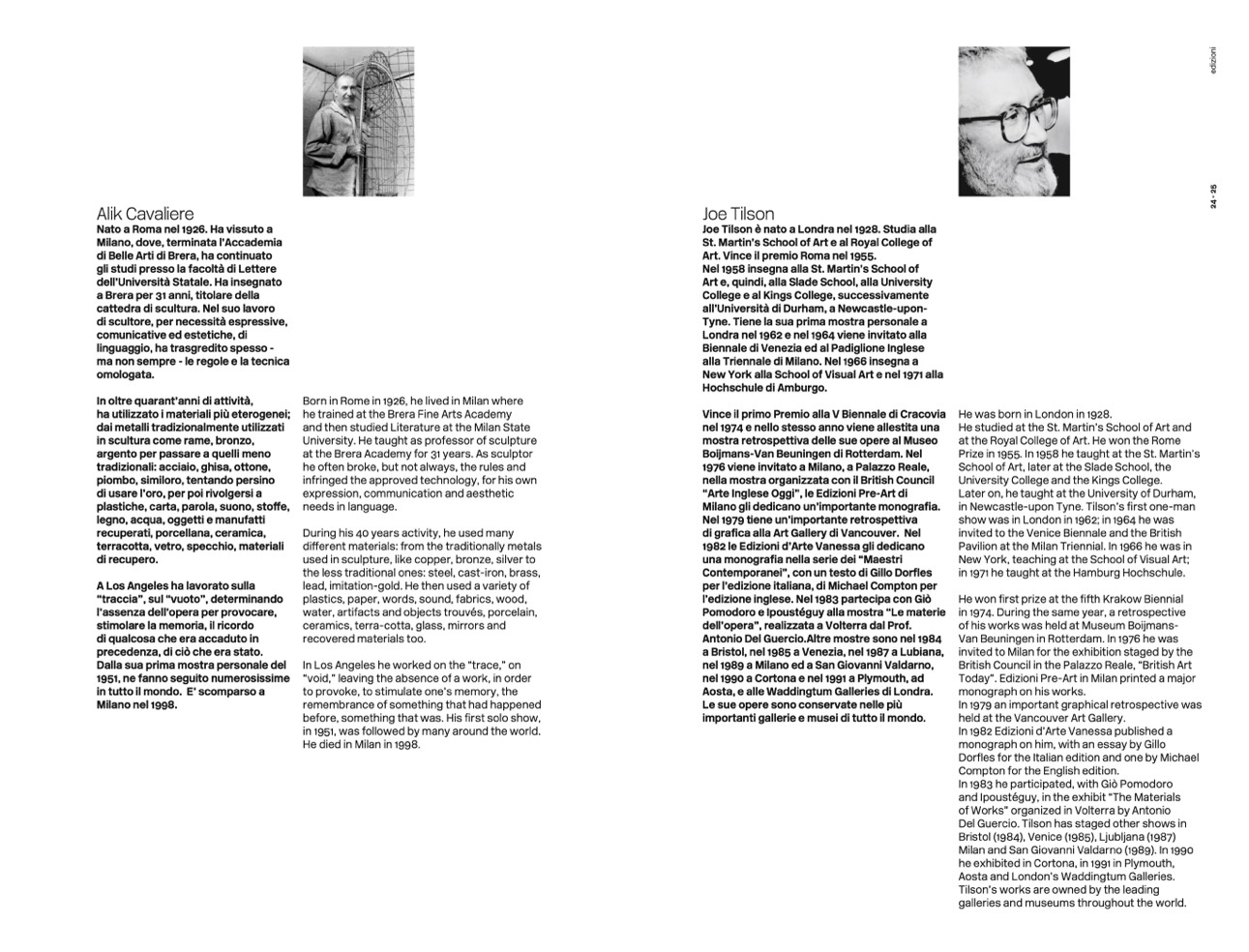
Alik Cavaliere
Nato a Roma nel 1926. Ha vissuto a
Milano, dove, terminata l’Accademia
di Belle Arti di Brera, ha continuato
gli studi presso la facoltà di Lettere
dell’Università Statale. Ha insegnato
a Brera per 31 anni, titolare della
cattedra di scultura. Nel suo lavoro
di scultore, per necessità espressive,
comunicative ed estetiche, di
linguaggio, ha trasgredito spesso -
ma non sempre - le regole e la tecnica
omologata.
In oltre quarant’anni di attività,
ha utilizzato i materiali più eterogenei;
dai metalli tradizionalmente utilizzati
in scultura come rame, bronzo,
argento per passare a quelli meno
tradizionali: acciaio, ghisa, ottone,
piombo, similoro, tentando persino
di usare l’oro, per poi rivolgersi a
plastiche, carta, parola, suono, stoffe,
legno, acqua, oggetti e manufatti
recuperati, porcellana, ceramica,
terracotta, vetro, specchio, materiali
di recupero.
A Los Angeles ha lavorato sulla
“traccia”, sul “vuoto”, determinando
l’assenza dell’opera per provocare,
stimolare la memoria, il ricordo
di qualcosa che era accaduto in
precedenza, di ciò che era stato.
Dalla sua prima mostra personale del
1951, ne fanno seguito numerosissime
in tutto il mondo. E’ scomparso a
Milano nel 1998.
Born in Rome in 1926, he lived in Milan where
he trained at the Brera Fine Arts Academy
and then studied Literature at the Milan State
University. He taught as professor of sculpture
at the Brera Academy for 31 years. As sculptor
he often broke, but not always, the rules and
infringed the approved technology, for his own
expression, communication and aesthetic
needs in language.
During his 40 years activity, he used many
different materials: from the traditionally metals
used in sculpture, like copper, bronze, silver to
the less traditional ones: steel, cast-iron, brass,
lead, imitation-gold. He then used a variety of
plastics, paper, words, sound, fabrics, wood,
water, artifacts and objects trouvés, porcelain,
ceramics, terra-cotta, glass, mirrors and
recovered materials too.
In Los Angeles he worked on the “trace,” on
“void,” leaving the absence of a work, in order
to provoke, to stimulate one’s memory, the
remembrance of something that had happened
before, something that was. His first solo show,
in 1951, was followed by many around the world.
He died in Milan in 1998.
Joe Tilson
Joe Tilson è nato a Londra nel 1928. Studia alla
St. Martin’s School of Art e al Royal College of
Art. Vince il premio Roma nel 1955.
Nel 1958 insegna alla St. Martin’s School of
Art e, quindi, alla Slade School, alla University
College e al Kings College, successivamente
all’Università di Durham, a Newcastle-upon-
Tyne. Tiene la sua prima mostra personale a
Londra nel 1962 e nel 1964 viene invitato alla
Biennale di Venezia ed al Padiglione Inglese
alla Triennale di Milano. Nel 1966 insegna a
New York alla School of Visual Art e nel 1971 alla
Hochschule di Amburgo.
Vince il primo Premio alla V Biennale di Cracovia
nel 1974 e nello stesso anno viene allestita una
mostra retrospettiva delle sue opere al Museo
Boijmans-Van Beuningen di Rotterdam. Nel
1976 viene invitato a Milano, a Palazzo Reale,
nella mostra organizzata con il British Council
“Arte Inglese Oggi”, le Edizioni Pre-Art di
Milano gli dedicano un’importante monografia.
Nel 1979 tiene un’importante retrospettiva
di grafica alla Art Gallery di Vancouver. Nel
1982 le Edizioni d’Arte Vanessa gli dedicano
una monografia nella serie dei “Maestri
Contemporanei”, con un testo di Gillo Dorfles
per l’edizione italiana, di Michael Compton per
l’edizione inglese. Nel 1983 partecipa con Giò
Pomodoro e Ipoustéguy alla mostra “Le materie
dell’opera”, realizzata a Volterra dal Prof.
Antonio Del Guercio.Altre mostre sono nel 1984
a Bristol, nel 1985 a Venezia, nel 1987 a Lubiana,
nel 1989 a Milano ed a San Giovanni Valdarno,
nel 1990 a Cortona e nel 1991 a Plymouth, ad
Aosta, e alle Waddingtum Galleries di Londra.
Le sue opere sono conservate nelle più
importanti gallerie e musei di tutto il mondo.
He was born in London in 1928.
He studied at the St. Martin’s School of Art and
at the Royal College of Art. He won the Rome
Prize in 1955. In 1958 he taught at the St. Martin’s
School of Art, later at the Slade School, the
University College and the Kings College.
Later on, he taught at the University of Durham,
in Newcastle-upon Tyne. Tilson’s first one-man
show was in London in 1962; in 1964 he was
invited to the Venice Biennale and the British
Pavilion at the Milan Triennial. In 1966 he was in
New York, teaching at the School of Visual Art;
in 1971 he taught at the Hamburg Hochschule.
He won first prize at the fifth Krakow Biennial
in 1974. During the same year, a retrospective
of his works was held at Museum Boijmans-
Van Beuningen in Rotterdam. In 1976 he was
invited to Milan for the exhibition staged by the
British Council in the Palazzo Reale, “British Art
Today”. Edizioni Pre-Art in Milan printed a major
monograph on his works.
In 1979 an important graphical retrospective was
held at the Vancouver Art Gallery.
In 1982 Edizioni d’Arte Vanessa published a
monograph on him, with an essay by Gillo
Dorfles for the Italian edition and one by Michael
Compton for the English edition.
In 1983 he participated, with Giò Pomodoro
and Ipoustéguy, in the exhibit “The Materials
of Works” organized in Volterra by Antonio
Del Guercio. Tilson has staged other shows in
Bristol (1984), Venice (1985), Ljubljana (1987)
Milan and San Giovanni Valdarno (1989). In 1990
he exhibited in Cortona, in 1991 in Plymouth,
Aosta and London’s Waddingtum Galleries.
Tilson’s works are owned by the leading
galleries and museums throughout the world.
2
4
-
2
5
e
d
i
z
i
o
n
i

